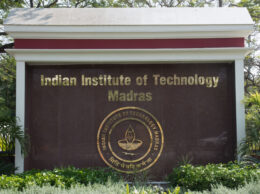Hyderabad, 30th July 2019: Indian Institute of Technology Hyderabad Researchers has developed a simple and innovative method to synthesize a catalyst that can convert chemicals derived from biomass into biofuel precursors. Their catalyst showed better efficiency and selectivity than commercial catalysts to produce the desired C15 oxygenated hydrocarbon, a precursor to diesel and jet fuel.
This development is important for India, especially for States such as Uttar Pradesh and Andhra Pradesh-Telengana duo, the first and second largest producers of corn in the country respectively. They produce a large amount of corncob waste, much of which waste is currently burnt as its potential to be converted to valuable fuels is not harnessed owing to lack of awareness, expertise and technology.
This Research by IIT Hyderabad on cheap and efficient catalyst can enable this conversion, which would trigger the cascade of additional earning opportunity for the corn-farmer, provision of a sustainable energy source and reduction of carbon footprint in the automobile/aviation sector.
The Research was led by Dr. Atul Suresh Deshpande, Assistant Professor, Department of Materials Science and Metallurgical Engineering, IIT Hyderabad, and Prof. Sunil Kumar Maity, Department of Chemical Engineering, IIT Hyderabad, along with their Research students, D. Damodar, K. Alekhya and Dr. V. Mohan. Their Research paper detailing the synthesis procedure and the catalytic efficiency of the material produced has been recently published in the reputed peer-reviewed journal, ACS Sustainable Chemistry and Engineering.
The global aviation sector, which will account for 3.5 per cent of CO2 emissions and 15 per cent of global oil demand by 2030, has resolved to achieve a 50 per cent reduction of carbon emissions by 2050. The use of biofuels – fuels that are derived from biological sources – instead of fossil fuels, is considered the most practical solution towards achieving this goal.
Biofuels are typically derived from plants waste such as corncobs, in many steps. For example, biofuels can be produced by the reaction between two chemicals, furfural and 2-methylfuran, both of which are derived from corncob. This reaction requires special enablers, or catalysts, such as activated carbon. These highly active carbon catalysts often require heat treatment of the precursors to temperatures more than 1000 degrees celcius.
The need for such high energy not only increases the cost of the catalyst but also negates the attempts to carbon-neutrality in developing the biofuel. The IIT Hyderabad team has developed a novel process that can produce carbon catalysts at room temperatures using simple materials – sugar, sulfuric acid and salt.
Explaining his research, Dr. Atul Suresh Deshpande said, “The dehydration of sugar by concentrated sulfuric acid is high-school chemistry. This reaction is highly exothermic, that means, intense heat is released during the reaction spontaneously, which helps in turning sugar into carbon without external heating. But this process is not well controlled and the resultant carbon does not have uniform micro-structure and catalytic prowess.”
Dr. Sunil Kumar Maity added, “Due to the low cost of precursors with practically zero energy input and simplicity of reaction, this process of producing carbons nanoplates can be easily adapted for large-scale commercial production.”
In order to control the microstructure of carbon during the exothermic dehydration of sugar, the researchers added common salt. Salt helps in controlled dehydration of sugar, which leads to the formation of carbon nanoplates –plate like structures that are a hundred thousand times smaller than the human hair. Not only is this nanostructure important because of the large surface area, but the surface is also covered by sulfonate groups that makes it an active catalyst.
The researchers did not stop with the speculation, they proved the catalytic power of their carbon nanoplates in the reaction between furfural and 2-methylfuran. Their catalyst showed better efficiency and selectivity than commercial catalysts to produce the desired C15 oxygenated hydrocarbon, a precursor to diesel and jet fuel.
The researchers at IIT Hyderabad believe that this novel approach can be further modified to obtain not just carbon nanoplates but also other types of nanostructured carbon materials that are useful in other commercial applications.








